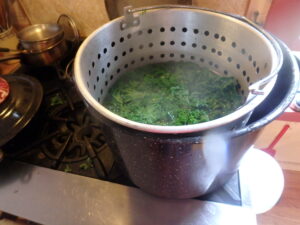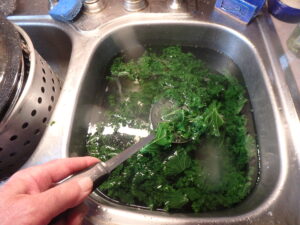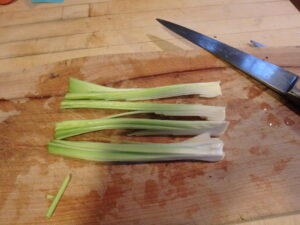Getting Ready for Winter
To blanch the kale I submerse it in boiling water for 30 to 60 seconds. This will kill the “aging” enzymes in kale, allowing me to keep it frozen and good to eat practically forever, if need be. Normally I eat all the kale within a year of freezing it, which is recommended. I could freeze kale without blanching it if I were planning on eating it all in 3 months or so. But blanching also allows me to pack more kale in each bag.
Next you want to cool the kale quickly. Some people prepare an ice bath, but I just fill the kitchen sink with cold tap water. I lift the blanching pot and let the water drain back into the canner. Then, with the lid of the canner under the pot, I move from stove to sink, and drop the kale into the cold water. I stir, then scoop it out with a colander or slotted spoon, and put it into my salad spinner. The brand I prefer is Zylis, which has a pull string, not a crank. Sometimes I squeeze the kale to get some of the water out before spinning it.
I grow a lot of leeks, in part because they freeze so well. I wash them, take off a layer or so of outer leaves, cut off the tops and quarter them lengthwise. I chop them, put them in freezer bags and suck out the air. They last forever in the freezer. I store lots of onions, but always run out before next year’s crop comes in. And onions don’t last forever, even in cool storage, so I use leeks in soups and stews when I run out of onions. I’ll put up a dozen quarts of leeks or more this year.
Keeping a Taste of the Garden to Eat This Winter
Every year the vegetable garden produces food for me. Some years I have enough to eat and to share – with plenty left to put up for the winter. But every year is different and this year my garden is a bit of a disappointment. Here it is the end of August and I’m not able to gorge on tomatoes the way I usually do. And although I only planted one zucchini plant this year, so far I’ve only harvested just one zucchini. Still, I will put some produce in the freezer, just not as much as I’d like.
For those gardeners with plenty, let’s take a look at some easy ways to put produce aside for use this winter. First, tomatoes: freeze them whole. Just put clean, dry tomatoes into freezer bags and suck the air out with a straw after closing the bag 99% of the way. Use them this winter in soups and stews the way you would canned tomatoes. Knowing that they are your own makes them even better. You can use them with the skins on, if you wish, but running hot tap water over the frozen tomatoes and rubbing gently will remove them.
In past years I have always dehydrated cherry tomatoes in my Garden Master Pro dehydrator after cutting them in half. The result is a “sun dried” tomato that is sweet and wonderful for stir fries and soups. But last summer I tried putting some in the freezer whole and liked them for cooking. I just throw the whole frozen cherry tomatoes in soups and they are great – and much less work than drying them.
Each year I use imperfect tomatoes to make paste. I cut out the bad parts, throw them in the food processor, and puree them. Then I boil down the resulting slurry in a heavy cast iron enameled pot until I can literally stand up a spoon in it. That takes all evening at low heat. I leave it overnight, cover off, and in the morning I spoon the paste into ice cube trays and freeze it. Later I put the cubes in freezer-grade zipper bags.
Many people don’t bother freezing summer squash and greens – or even green beans and broccoli because they’ve had bad luck with the results: mushy, overcooked veggies. But there are a few simple steps you can take to have wonderful, fresh-tasting crunchy vegetables in mid-winter – that were grown in your own garden.
Many vegetables taste better, mid-winter, if they have been blanched –briefly boiled – before freezing. Blanching is way of killing aging enzymes in veggies so that the produce put in the freezer does not get woody, old and tasteless. But many “experts” suggest blanching fresh veggies for 3 minutes, or even more. In my book, that is fully cooking them. And when you cook them again before eating,the result is mush.
The solution? Blanch for just 60 seconds or so. Depending on your stove, that may mean not even getting the water back up to a full boil. The trick is to have lots of water at a rolling boil, and not too many veggies. I watch the color of my vegetables as I blanch them. Kale, for example, will turn a brighter green – telling me that it’s ready to take off the heat.
It’s important to cool your blanched vegetables as soon as they come out of the pot. Some experts recommend dropping them in a big bowl of water with ice cubes. Me? I’m too cheap to buy ice cubes in the quantity I would need. I just fill the sink with cold tap water, and it works just fine. Next I spin dry the veggies in a salad spinner with a string-pull (Zyliss brand in one) and blot dry with tea towels before bagging and putting in the fridge.
My exceptions to blanching include tomatoes, peppers and all berries. Everything else gets a quick swim in boiling water. Last year a kind reader suggested that kale need not be blanched, so I tried freezing some without blanching. It was fine, but less kales fit into each bag.
Dehydrating fruits and vegetables is another good way to store food, particularly if you don’t have much freezer space. Apples and pears dry nicely and make for good winter snackage. Even if you don’t grow your own, you can buy/pick fresh apples cheaper than buying dried fruit. I dry apples and pears until they are dry, but not brittle. I store them in freezer grade bags in the pantry.
Peppers and tomatoes, sliced, dry well and are great in winter soups and stews. I dry most of my hot peppers until brittle and then grind them in my coffee grinder. That allows me to add just a smidgeon of hotness if having company – or a lot if it’s just for me. I have read that the seeds and the white fibers inside the pepper contain a lot of capsaicin, the chemical that gives hot peppers their heat, so I dry those, too.
I’ve gotten a lot of e-mail from discouraged gardeners this year. It wasn’t a great year for many of us. But there are still farm stands selling fresh produce, and often they will sell cheaply by the bushel if you want to store food for the winter. I may end up doing so myself.
Send questions, suggestions and laments to Henry by e-mail at henry.homeyer@comcast.net or by mail at P.O. Box 364, Cornish Flat, NH 03746. Please include a stamped envelope if you wish an answer by mail.






